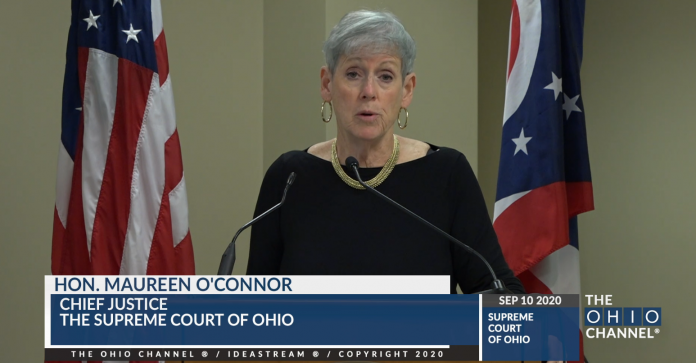By Susan Tebben
The true nature of justice lies in its ability to change when society calls for it, according to the head of Ohio’s highest court.
Ohio Supreme Court Chief Justice Maureen O’Connor said that change is coming in the form of safety measures related to the COVID-19 pandemic and rethinking the justice system in light of nationwide civil unrest.
“Society’s problems are laid at our doorstep, and rightfully so,” O’Connor said in her recent State of the Judiciary address to the Ohio Judicial Conference annual meeting.
On the theme of the conference, acknowledging the anniversary of the 19th Amendment, she spoke of the protests that led to the passage of the law that gave women the right to vote. She also brought up the protests spawned by the death of George Floyd at the hands of police, but said the resentment felt by the protesters “is not the result of that one incident alone.”
“The history of our nation is one of immense contradictions,” O’Connor said. “…Barriers enacted by lawmakers and upheld in courts have restricted access to capital, and certain neighborhoods based on color. The list of injustices is long and the effects have reached from one century, into another, into another.”
Change for the better, O’Connor said, “requires steadfastness, it requires protest.” In making that change, the courts need better data and better tools to collect the data to investigate whether it’s being done fairly and equitably.
The chief justice made yet another push for a sentencing database that would monitor punishment statistics as well as demographics of defendants, something she and other legal officials have said should already be a part of Ohio’s justice system.
“Establishing a sentencing database may be hard, but it is not impossible and more importantly it is necessary,” O’Connor said.
The database is one of many tools O’Connor said should be utilized to bring Ohio’s justice system into the future, and combat accessibility issues brought on by societal gaps along with the pandemic.
Following guidelines from the Ohio Department of Health presented barriers to the court system, O’Connor said, but it also allowed the court system to identify new ways of being efficient, and ways for parties to participate in court proceedings without being present.
The $6 million the Ohio Supreme Court released in March to help local courts continue while preventing the spread of COVID-19 was accepted immediately by 87 of the 88 counties in the state, according to O’Connor. Some courts have now resumed jury trials, and some courts are now able to stream their hearings virtually.
“A court’s ability to provide proper access to justice while employing these technologies is something new,” O’Connor said.
Pilot projects are currently being undertaken by the National Center for State Courts to determin the public perception of these electronic appearances, and the state supreme court is working on guidance for these virtual hearings.
The supreme court is also starting a “virtual directory” of courts that allow streaming of their court proceedings. The high court has already streamed their oral arguments, but the Barberton Municipal Court, the Ottawa County Court of Common Pleas, along with the Ninth and 10th District courts of appeals are now listed as part of the directory.
O’Connor and the court also announced the iCourt Task Force, to study the use of technology by courts during the coronavirus pandemic. The task force plans to survey judges and attorneys and look comprehensively at what rules and protocols should be in place to make technology work for the courts. The concept of remote criminal jury trials is also a topic up for consideration by the task force.
The task force will have a maximum of 25 members appointed by Chief Justice O’Connor, and will include court officials from justices to clerks of courts, and Justice Patrick DeWine will serve as the high court’s liaison.
A deadline for findings and recommendations was set for June 2021, according to the supreme court.
***
Also from Ohio Capital Journal:
Fundamental questions remain as Medicaid revamps drug spending
The Ohio Department of Medicaid is undertaking a massive overhaul of how it pays for more than $3 billion worth of prescription drugs a year. It’s planning to implement the changes by March, but so far it hasn’t answered basic questions about how it will be done.
That has lawmakers and the companies that work with the department worried and frustrated.
“I think (Medicaid Director Maureen Corcoran) is pretty headstrong on proceeding and I think she’s the only one who feels that way,” said Sen. Dave Burke, R-Marietta, chairman of the Joint Medicaid Oversight Committee. “There are definitely things that give me pause and the organizations that are going to actually implement this policy like the managed care organizations.”
Amid persistent and growing questions about whether middlemen known as pharmacy benefit managers, or PBMs, are overcharging taxpayers, lawmakers and other state officials have for years been casting about for reforms. READ MORE
Nearly 7,000 COVID-19 cases reported last week in Ohio
The coronavirus’ spread slightly waned last week in Ohio as the seven-day moving average of newly reported cases dipped below 1,000.
All told, 4,415 Ohioans have died from COVID-19. More than 14,300 have been hospitalized of the more than 137,000 residents who have been infected, according to Sunday data from the Ohio Department of Health.
Nearly 7,000 cases were reported last week. READ MORE





